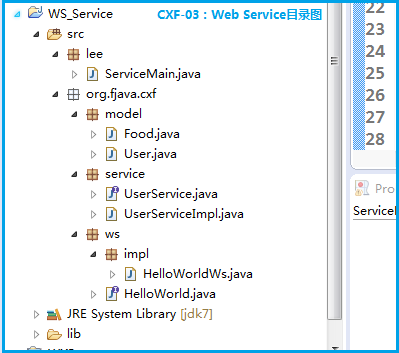有了 CXF-01、CXF-02 的铺垫,我们开始更深一步的探索 CXF 的秘密,可以直接按照下面的代码进行更改:
* 当形参、返回值的类型是String、基本数据类型时,CXF可以处理;
* 当形参、返回值的类型是JavaBean式的复合类、List集合、数组等时,CXF可以处理;
* 还有一些像 Map、非JavaBean式的复合类,CXF不可以处理;
* 代码有时比语言更犀利,在代码中前行,在代码中享受汲取的乐趣:
* 1 . 增加一个形参、返回值的类型是JavaBean式的复合类、List集合、数组等的方法
import java.util.List;
import javax.jws.WebService;
import org.fjava.cxf.model.Food;
import org.fjava.cxf.model.User;
@WebService//J2EE文档里查看WebService
public interface HelloWorld {
//返回的String类型
String sayHello(String name);
//这个方法的形参和返回值都是比较复杂的类型,User对象是没有的
List<Food> getFoodsByUser(User user);
}import java.util.Date;
import java.util.List;
import javax.jws.WebService;
import org.fjava.cxf.model.Food;
import org.fjava.cxf.model.User;
import org.fjava.cxf.ws.HelloWorld;
import org.fjava.cxf.service.UserService;
import org.fjava.cxf.service.UserServiceImpl;
@WebService(endpointInterface="org.fjava.cxf.ws.HelloWorld", serviceName="HelloWorldWs")
//endpointInterface=""表示实现的接口 serviceName是wsdl2java或其他语言后的文件名,可以不和HelloWorldWs相同
public class HelloWorldWs implements HelloWorld {
@Override
public String sayHello(String name) {
return "Hello ! " + name + ",您好" + "现在时间是:" + new Date();
}
@Override
public List<Food> getFoodsByUser(User user) {
// 在实际的项目中,Web Service组件自己并不会去实现业务功能,交给业务逻辑组件去实现
// 它只是调用业务逻辑组件的方法来暴露Web Service
UserService userService = new UserServiceImpl();
return userService.getFoodsByUser(user);
}
}public class Food {
private Integer id;
private String name;
private String describe;
public Food() {
super();
}
public Food(Integer id, String name, String describe) {
super();
this.id = id;
this.name = name;
this.describe = describe;
}
public Integer getId() {
return id;
}
public void setId(Integer id) {
this.id = id;
}
public String getName() {
return name;
}
public void setName(String name) {
this.name = name;
}
public String getDescribe() {
return describe;
}
public void setDescribe(String describe) {
this.describe = describe;
}
}
public class User {
private Integer id;
private String name;
private String tel;
private String describe;
public Integer getId() {
return id;
}
public User() {
super();
}
public User(Integer id, String name, String tel, String describe) {
super();
this.id = id;
this.name = name;
this.tel = tel;
this.describe = describe;
}
public void setId(Integer id) {
this.id = id;
}
public String getName() {
return name;
}
public void setName(String name) {
this.name = name;
}
public String getTel() {
return tel;
}
public void setTel(String tel) {
this.tel = tel;
}
public String getDescribe() {
return describe;
}
public void setDescribe(String describe) {
this.describe = describe;
}
@Override
public int hashCode() {
final int prime = 31;
int result = 1;
result = prime * result + ((describe == null) ? 0 : describe.hashCode());
result = prime * result + ((name == null) ? 0 : name.hashCode());
return result;
}
@Override
public boolean equals(Object obj) {
if (this == obj)
return true;
if (obj == null)
return false;
if (getClass() != obj.getClass())
return false;
User other = (User) obj;
if (describe == null) {
if (other.describe != null)
return false;
} else if (!describe.equals(other.describe))
return false;
if (name == null) {
if (other.name != null)
return false;
} else if (!name.equals(other.name))
return false;
return true;
}
}import java.util.List;
import org.fjava.cxf.model.Food;
import org.fjava.cxf.model.User;
public interface UserService {
List<Food> getFoodsByUser(User user);
}import java.util.ArrayList;
import java.util.HashMap;
import java.util.List;
import java.util.Map;
import org.fjava.cxf.model.Food;
import org.fjava.cxf.model.User;
public class UserServiceImpl implements UserService {
//为简单,不写Dao层,用一个HashMap来模拟内存中的数据库
static Map<User, List<Food>> foodDb = new HashMap<>();
static{
List<Food> catList1 = new ArrayList<Food>();
catList1.add(new Food(1 , "一个汉堡" , "是三层的,有夹层哦!"));
catList1.add(new Food(2 , "火腿肠" , "这是章鱼哥从岸上偷运来的,据说很美味!"));
foodDb.put(new User(1 , "海绵宝宝" , "123123123" , "开心的海绵宝宝!") , catList1);
List<Food> catList2 = new ArrayList<Food>();
catList2.add(new Food(3 , "蟹王汉堡" , "橙色,亮金色,我的宝贝,我的爱!"));
catList2.add(new Food(4 , "海绵金币" , "吃着金币样的甜甜饼,想着海绵宝宝赚的钱被扣了,哈哈哈,爽气!"));
foodDb.put(new User(2 , "蟹老板" , "321321321" , "哇!好有钱的蟹老板") , catList2);
}
@Override
public List<Food> getFoodsByUser(User user) {
return foodDb.get(user);
}
}* 4 . 执行 wsdl2java 命令,重新生成客户端代码(执行详情见:CXF-02:使用CXF开发Web Service客户端http://blog.csdn.net/cheng_feng_xiao_zhan/article/details/52683987)
* 5 . 修改客户端执行代码(在CXF-2里你在 src 下新建 Package ,新建的 Class 那个执行类)
import java.util.List;
import org.fjava.cxf.ws.Cat;
import org.fjava.cxf.ws.Food;
import org.fjava.cxf.ws.HelloWorld;
import org.fjava.cxf.ws.User;
import org.fjava.cxf.ws.impl.HelloWorldWs;
public class ClientMain {
public static void main(String[] args) {
//这是命令生成的类,该类的实例可当成工厂来使用
HelloWorldWs factory = new HelloWorldWs();
//无参的方法,返回的是远程Web Service服务端的代理,服务端不能关闭。
HelloWorld helloWorld = factory.getHelloWorldWsPort();
System.out.println(helloWorld.sayHello("海绵宝宝"));
//调用 'wsdl2java' 命令重新生成java文件,新生成的bean里没有构造方法
User user1 = new User();
//在服务端里的bean里设置的相同的规则(在服务端User类里)是姓名相同则认定为同一人
user1.setName("海绵宝宝");
user1.setDescribe("开心的海绵宝宝!");
List<Food> foodsByUser1 = helloWorld.getFoodsByUser(user1);
for (Food food : foodsByUser1) {
System.out.println(user1.getName() + "的食物:" + food.getName() + " " + food.getDescribe() + user1.getDescribe() + "!");
}
User user2 = new User();
//在服务端里的bean里设置的相同的规则(在服务端User类里)是姓名相同则认定为同一人
user2.setName("蟹老板");
user2.setDescribe("哇!好有钱的蟹老板");
List<Food> foodsByUser2 = helloWorld.getFoodsByUser(user2);
for (Food food : foodsByUser2) {
System.out.println(user1.getName() + "的食物:" + food.getName() + " " + food.getDescribe() + user2.getDescribe() + "!");
}
}
}* 6 . 运行成功:
Hello ! 海绵宝宝,您好现在时间是:Sat Oct 01 01:43:10 CST 2016
海绵宝宝的食物:一个汉堡 是三层的,有夹层哦!开心的海绵宝宝!!
海绵宝宝的食物:火腿肠 这是章鱼哥从岸上偷运来的,据说很美味!开心的海绵宝宝!!
海绵宝宝的食物:蟹王汉堡 橙色,亮金色,我的宝贝,我的爱!哇!好有钱的蟹老板!
海绵宝宝的食物:海绵金币 吃着金币样的甜甜饼,想着海绵宝宝赚的钱被扣了,哈哈哈,爽气!哇!好有钱的蟹老板!注:如何设置CXF的服务端端口号:这是公司规定或个人设置,不可重复
import javax.xml.ws.Endpoint;
import org.fjava.cxf.ws.HelloWorld;
import org.fjava.cxf.ws.impl.HelloWorldWs;
//发布Web Service
public class ServiceMain {
public static void main(String[] args){
HelloWorld hw = new HelloWorldWs();
//调用Endpoint的publish("本机地址","服务的提供者:一个Web Service对象")方法发布Web Service
//如何设置cxf的服务端端口号:这是公司规定或个人设置,不可重复
Endpoint.publish("http://192.168.1.3:6786/sayHello", hw);
System.out.println("Web Service暴露成功!");
//暴露成功后可以被任何平台的任何语言调用
//检查调用地址http://192.168.*.*/sayHello?wsdl
}
}希望对你有帮助,祝你有一个好心情,加油!
若有错误、不全、可优化的点,欢迎纠正与补充;转载请注明出处!
